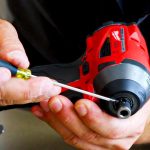Table of Contents
Drill bits are most common among professionals. These are cutting tools that are used to drill into any kind of material. However, these can benefit anyone involved in craftsmanship or other woodworking projects. But it is important to know which drill bit is suitable for your job so that you don’t damage the material while attempting to drill into it. Below we have enlisted ten types of drill bits and their functions for various purposes.
Anatomy Of A Drill Bit
But before that, let’s get to know a little about the drill bit structure in general. It has mainly three sections; Shank, Body, and the Point. Shank is the part that fits into a drill machine chuck. The Point is the most vital part that initiates the hole into any surface. And, the Body is the largest part in a drill bit that holds all the essential components of a drill bit that makes one different from the other.
Different Types Of Drill Bits
There are several drill bits you will find in the market. They vary from each other depending on the material, structure, and uses. However, below we have mentioned the most widely used drill bits that will assist you for various drilling purposes.
Twist Drill Bits
Twist Drill Bits are mostly constructed from high-speed steel or carbon steel. As a result, these drill bits can withstand high temperatures when drilling at high pressure. These bits come in various sizes to help you drill holes of different diameters. In general, twist drill bits are ideal for drilling holes in metal, timber, plastic, and other materials. The unique feature of this drill bit is it channels chips and dust from the hole as you work.
Masonry Bit
Mansory bits have a tungsten carbide tip with spiraled steel shaft. These types of drill bits are mainly used for drilling through quarry tiles, stone, concrete surfaces, and many more. Masonry drill bits are used with the power drills to produce enough power to drill through tough concrete surfaces. However, these bits rapidly heat up due to immense strain on them. So make sure to dip the drill bit in cold water as you work.
Auger Bits
If you are looking to drill into dry and thick wood, Auger bits can be the right drill bit for you. While drilling with this drill bit, you do not have to put much pressure on it as it has a screw-thread tip that effortlessly drags the drill into the material. These drill bits are capable of drilling large, deep holes into the wood. In addition, Auger bits are amazing for creating clean holes by removing chips and dust while drilling.
Step Bits
As the name suggests, step bits are designed like a pyramid with multiple steps. These drill bits are used for drilling holes with different diameters with one single bit. The step bit has a cone-shaped head. So as you go down, the hole size increases. These drill bits are incredibly well for drilling thin metal or wood sheets. For their versatility, step bits are often used by professionals to drill a variety of holes in plywood, particleboard, and drywall, without needing to change the bit.
Self-Feed Bits
These are almost like the Forstner (used for finishing woodcutting) bits but are used for powering through wood as fast as possible. Like the Auger bits, self-feed bits have a screw tip. This tip helps you locate the position of your surface. These drill bits are mostly used for concealed hinges that are often found on kitchen cabinets. They come in sizes ranging from 26 to 35 mm and can drill large-diameter holes in wood. Self-feed drill bits can create clean and precise holes. But the only problem with these drill bits is you need to halt drilling periodically to clear the accumulated dust away from the hole.

Plug Cutting Bit
Plug Cutting bits are used for creating wood plugs that can be used for hiding the screw heads on their workpiece. So to create wood plugs, there is no better drill bit than a Plug cutting bit.
Countersink Bits
If you want to hide the screw head after drilling a hole, then a countersink drill bit is what you need. This type of drill bit widens the drilled hole so that the screw head sinks below the workpiece. Then this hole can be filled over and painted. That way, it makes the workpiece look pristine. These drill bits come in a variety of sizes. Countersink Bits are outstanding for drilling holes such as counterbore and pilot holes into the wood.
Flatwood Bit
This type of drill bit is designed with a pointed center to help you drill a pilot hole into the wood. Flatwood bits are compatible with a power drill and screwdrivers, both corded and cordless. Its two cutting edges beside the pointed center effortlessly make a large hole into the workpiece. That way, these drill bits leave a flat-bottomed hole in the drilled surface. Flatwood drill bits are also known as Spade drill bits because of the flat drill head. However, they are pretty lightweight and are great for those who want to pack a light toolbox.
Tile Bits
Drilling a hole in ceramic tiles or glass can be quite tricky as they can shatter within seconds if too much pressure is applied. Tile Bits are best for this type of drilling purpose. It is designed with a diamond or tungsten carbide tip that smoothly drills into hard surfaces. These drill bits are mostly compatible with a power drill or hand drill. But start off drilling at a slow speed. Also, use lubricant when drilling glasses with Tile Bits. So the carbide tip stays cool.
Spur Point Bit
The Spur Point Bit is also used for drilling wood. It cuts wood a lot faster when used in a power drill. Most importantly, the spur point bit is a clean-sided hole. As the name suggests these bits have a central shape point with two elevated spurs on the sides. These two spurs on the side assist in drilling straight. These bits can be used for drilling holes in plastic as well.
At this point, you have got an overall idea of which drill bit is suitable for your project. Some are great for drilling through hard and thick surfaces, whereas some are suitable for creating smooth holes into flat, thin surfaces. But without having the right one in your hand, you might damage your workpiece. So choose wisely.










Leave a Comment